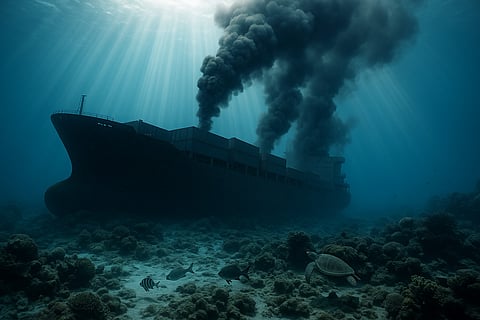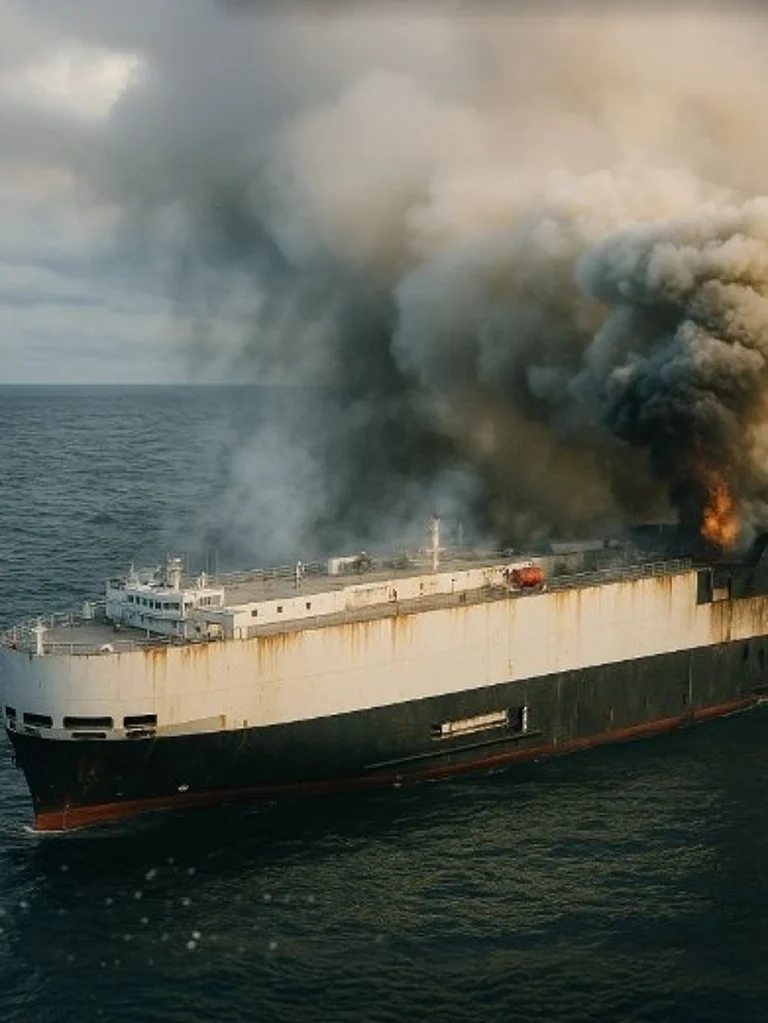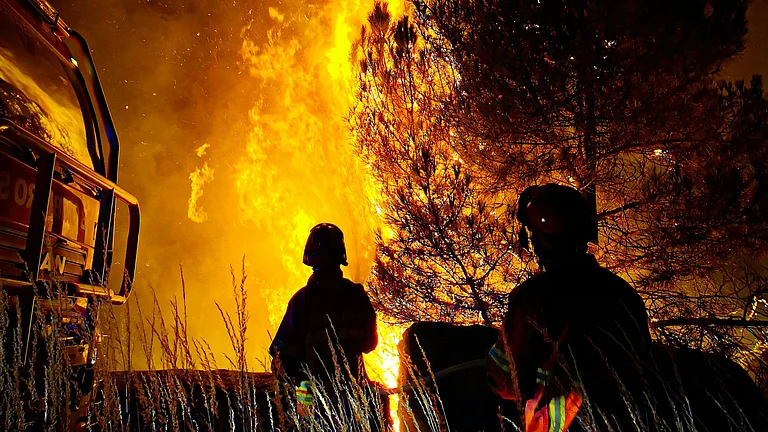A cargo ship carrying 3,000 vehicles including 800 electric vehicles caught fire on June 3 in waters off Alaska’s Aleutian island chain. The uncontrollable blaze led the crew to abandon the ship and make way for safe shores.
How the Morning Midas Shipwreck Impacts Marine Biodiversity—Explained
The EV-fuelled blaze and sinking of the cargo ship off Alaska’s coast raises concerns not just about battery safety but also long-term risks to ocean ecosystems
The initial images shared by the US Coast Guard, according to Mint, showed a large plume of smoke emanating from the ship’s stern, from the deck housing electric vehicles.
Zodiac Maritime, a London based company that operates the cargo ship, Morning Midas gave a confirmation in a statement, saying, “The relevant authorities have been notified, and we are working closely with emergency responders with a tug being deployed to support salvage and firefighting operations.”
The ship had 22 people on board, all of who were reportedly safe. All the 22 crew members aboard the Morning Midas evacuated the ship aboard a life boat and were subsequently rescued by the crew of motor vessel Cosco Hellas, one of the Good Samaritan vessels on scene, with no reported injuries so far.
Further, according to the United States Coast Guard, the Morning Midas carried 3,048 vehicles, with 70 EVs and 681 hybrid electric vehicles, all of which sank with the ship.
What Caused the Morning Midas Cargo Ship Fire?
Zodiac Maritime reportedly asserted that the inferno began in the EV section, indicating a lithium-ion battery ignition as a possible trigger. However, the exact details are still under investigation.
Lithium-ion batteries, embedded in EVs, are very safe in ideal conditions. However, they are prone to “thermal runaway”, a chemical reaction that gets triggered once batteries get damaged—both in case of internal short circuit or external damage. Extreme cases also lead to explosion of battery, producing intense fires that are difficult to extinguish.
This risk grows multifold when lithium-ion batteries come in contact with water. Instead of diffusing the fire, water can act as a fuel, causing it to burn intensely due to the formation of flammable hydrogen gas, which adds layers of hazard to a dangerous situation.
The ship’s CO2 fire suppression system failed after exhausting its supply, as lithium-ion fires require vast amounts of water—up to 10,000 gallons per vehicle. HT quoted Sean DeCrane of the International Association of Fire Fighters as saying that the fire’s behaviour was “consistent with known EV ignition patterns,” particularly with ineffective CO2 systems.
As per HT, any specific brand has not been linked to the ignition and Chinese carmaker Great Wall Motor Co. confirmed that its 140 vehicles were not EVs and were on a different deck.
According to reports, the fire burned for weeks and spread across multiple decks. Making the situation worse last week, severe weather led the ship to sink in 5,000-meter-deep waters. The vessel also carried 350 metric tons of gas fuel and 1,530 metric tons of very low-sulfur fuel oil.

How Shipwrecks Affect Marine Biodiversity?
Shipwrecks can enhance marine biodiversity by acting as artificial reefs or biodiversity hotspots and providing habitat for fish, corals and microorganisms, according to a 2024 Cranfield University.
Dr Peter Campbell from the Cranfield Forensic Institute said: “Our research examines the fascinating world of shipwrecks, revealing how underwater heritage serves as dynamic ecosystems.
“Shipwrecks stand as poignant reminders of the intricate relationship between human culture and the natural world. From micro-organisms to large predators and marine mammals, they support a thriving habitat that enriches biodiversity in ways we are only beginning to comprehend.”
However, they can also lead to the introduction of pollutants or invasive species in the ecosystem, requiring long-term ecological monitoring. The US National Library of Medicine underscored that the degradation of metallic shipwrecks endangers the fragile reef ecosystems that develop around them in addition to releasing harmful substances into the environment. This calls for an urgent, multidisciplinary research to protect these underwater cultural and ecological sites.
Shipwrecks With Lingering Impact
Other notable shipwrecks that damaged the marine ecosystem in the past and can be studied for understanding the devastating impact of debris in the sea include the sinking of SS Jacob Luckenback in California USA on July 14, 1953, according to US National Oceanic and Atmospheric Administration (NOAA) Office of Response and Restoration.
The freighter SS Jacob Luckenbach collided with another vessel and sank in the Gulf of the Farallones. As it decayed on the ocean floor, it leaked oil and became the source of many oil spills for years to come. It was not until January 2002 that these “mystery spills” connected to the Luckenbach when oiled seabirds started to appear on beaches from Bodega Bay on the Sonoma Coast to Monterey Bay along the central coastline of California. The US Coast Guard and NOAA confirmed that oil was leaking from the wreck, prompting the United States Coast Guard’s National Pollution Funds Center (NPFC) to spend roughly $20 million from the federal Oil Spill Liability Trust Fund to offload as much oil as possible in 2002.
Another incident known as New Zealand’s worst ever maritime environmental disaster, was the one when container ship MV Rena ran aground on Astrolabe Reef due to navigational error. As the ship shifted and broke on the reef, as many of the 1,368 containers (121 with perishable goods and 32 with ‘dangerous goods’) on board broke loose and fell into the sea in New Zealand in 2011. According to New Zealand Journal of Marine and Freshwater Research, up to 350 tonnes of heavy fuel oil (HFO) were released into the sea leading to contamination of the sea and long-term declines in local fish and coral populations.
Another shipwreck that continues to pose high ecological risk is the SS Montebello, a WWII-era oil tanker torpedoed by an Imperial Japanese submarine off the coast of Cambria, California in 1941. The vessel sits on the seafloor at a depth of approximately 275 meters (900 feet), presumably with its tanks full of Santa Maria crude oil, according to Phys.org. A 2010 US NOAA study used remotely operated vehicles (ROVs) to confirm that the ship still held millions of gallons of oil, but had not yet started leaking significantly, making it a potential environmental time bomb.


